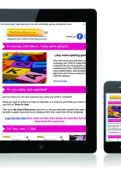Important update from TheSchoolRun
For the past 13 years, TheSchoolRun has been run by a small team of mums working from home, dedicated to providing quality educational resources to primary school parents. Unfortunately, rising supplier costs and falling revenue have made it impossible for us to continue operating, and we’ve had to make the difficult decision to close. The good news: We’ve arranged for another educational provider to take over many of our resources. These will be hosted on a new portal, where the content will be updated and expanded to support your child’s learning.
What this means for subscribers:
- Your subscription is still active, and for now, you can keep using the website as normal — just log in with your usual details to access all our articles and resources*.
- In a few months, all resources will move to the new portal. You’ll continue to have access there until your subscription ends. We’ll send you full details nearer the time.
- As a thank you for your support, we’ll also be sending you 16 primary school eBooks (worth £108.84) to download and keep.
A few changes to be aware of:
- The Learning Journey weekly email has ended, but your child’s plan will still be updated on your dashboard each Monday. Just log in to see the recommended worksheets.
- The 11+ weekly emails have now ended. We sent you all the remaining emails in the series at the end of March — please check your inbox (and spam folder) if you haven’t seen them. You can also follow the full programme here: 11+ Learning Journey.
If you have any questions, please contact us at [email protected]. Thank you for being part of our journey it’s been a privilege to support your family’s learning.
*If you need to reset your password, it will still work as usual. Please check your spam folder if the reset email doesn’t appear in your inbox.
Making sense of the SEN Code of Practice

With around one in five UK children having some sort of special educational needs at some point in their school life, the SEND Code of Practice document (2014) aims to provide extensive support for pupils, teaching staff, and parents.
An enormously in-depth document, the SEND Code of Practice can be overwhelming to look at. But it gives practical guidance on policies and procedures aimed at enabling children with learning difficulties to reach their full potential. It covers issues such as inclusion, and offers support for children making the successful transition to adulthood.
In the new edition of the Code which came into practice in 2014, the age range that it applies to has been extended up to 25 years of age, and it now calls on councils and local health partners to come up with a joint education, health and care (EHC) plan providing integrated support for children and young people with more complex needs than can be handled by their school alone.
There are also changes to allow children and young people to have a budget for their needs.
Starting with the school years, the Code suggests a graduated response when dealing with special educational needs in school. This means that the recommended action depends on the seriousness of the special needs.
Here are the main types of action for a SEND child in a mainstream school:


Boost Your Child's Learning Today!
- Start your child on a tailored learning programme
- Get weekly English & maths resources sent direct to your inbox
- Keep your child's learning on track
SEN Support in Schools
Where a pupil is identified as having SEN, schools should take action to remove barriers to learning and put effective special educational provision in place. This should be a four-part cycle:
- Assess: analyse the child’s current performance, with information from teachers, parents and other supporters and professionals.
- Plan: the teacher and the special educational needs co-ordinator (SENCO) should agree, in consultation with the parent and the pupil, the adjustments, interventions and support to be put in place, as well as the expected impact on progress, development or behaviour, along with a clear date for review.
- Do: the teacher and teaching assistants put the plan in place, with support from the SENCO.
- Review: assess how the plan is working. If the child also has an EHC plan this must be done every 12 months.
EHC plan
While some children’s needs are met by their school, some need further input and assisstance, which is covered by an education, health and care (EHC) plan. Assessment is the step before the child can have an EHC plan, but does not necessarily mean the child will get one. It is a detailed investigation to find out more about the child’s special educational needs, and what provision is needed to meet those needs. It is conducted by the local authority and can take into account the views of professionals, parents and teachers.
Tips for parents
- It’s always best to approach the class teacher and special needs coordinator with any worries you may have. If you are still unhappy, arrange a meeting with the head teacher.
- Keep a record of all the meetings and actions taken. Write down any questions you may have, and make sure you understand what is discussed.
- Bring a ‘named person’ with you if you would like extra support. This person could be a friend, relative, or professional. Your Local Authority may have a list of volunteers who have been trained as named persons.
- Consult your child’s school’s special needs policy, as it will describe how to handle complaints. If you are still unhappy, try contacting the school’s Local Authority or governing body.
- Remember not to be afraid to ask questions or expect the very best care for your child.








